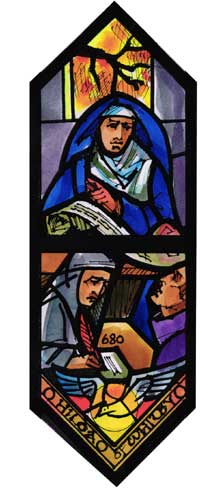|
|
|||

|
|||
Hilda of Whitby
Window
 By the middle of the sixth century, Celtic Christianity had spread from Ireland to Iona, a small island off the Scottish coast. While Augustine was introducing Roman Christianity to Anglo-Saxon England, Celtic Christianity was growing among the native Britons in the North and West. The seventh century saw the rapid spread of both traditions, but the British and English churches were not united. The eventual union would occur in 664, with the help of Hilda, the abbess of Whitby. Hilda was born into the royal family of Northumbria, and brought up at the court of her great-uncle, King Edwin. The queen’s chaplain was the bishop Paulinus, a former companion of Augustine of Canterbury, and as a result, Hilda’s early Christian training was in the Roman tradition. When she was about 20, Edwin was killed in battle, and Hilda fled, intending to enter a convent in France. Within the year, however, the kingdom once again changed hands, and Oswald, a Celtic Christian, became ruler of Northumbria and summoned the great monk, Aidan, from Iona. Aidan, in turn, called Hilda back and made her abbess of Hartlepool, where she formed a rule of life from the teachings of both Paulinus and Aidan. Renowned for her wisdom and devotion to God, she became counsel to kings and nobles, and eventually founded the double monastery at Whitby, where both nuns and monks lived in strict obedience to her rule. Meanwhile, though the Roman and Celtic traditions agreed doctrinally, their differing practices caused so much confusion in Northumbria, that the king called for a synod to be held at Whitby. There the direction of the English Church was finally decided, and England was brought into the fold of Catholic Christendom. Many Celtic Christians, including Hilda, supported the decision, choosing unity with the larger Church over continued isolation. Hilda, in particular, helped to reconcile Celtic Christians to adopting new customs. She remained at Whitby for the rest of her life, teaching her children to live together in peace and love. This window portrays the deep rift within the Church that Hilda helped to heal. The scroll in her hand is the Rule of life by which she governed her monastery. Two Christians, one Roman (in purple) and one Celtic (in white), receive her wisdom as the Holy Spirit (shown as a dove) guides the synod, and a new era dawns for the English Church.
Like Stars Appearing: The Story of the Stained Glass
Windows of St. George's Episcopal Church, Dayton, Ohio | |||
|
|||
